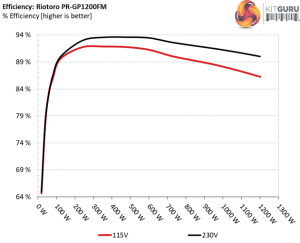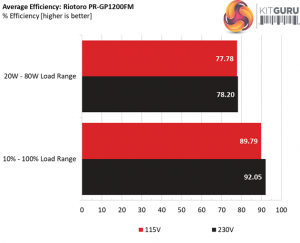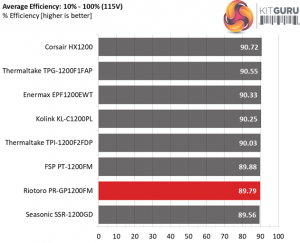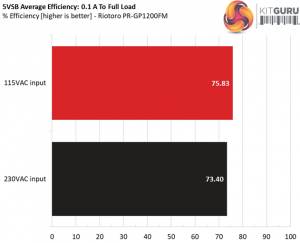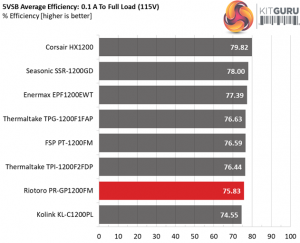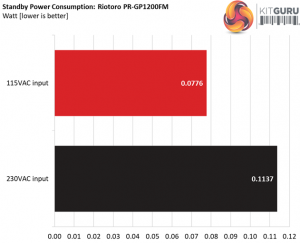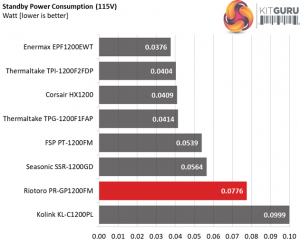Efficiency
Our efficiency testing procedure is detailed here.
Using results from the previous page, we plotted a chart showing the PR-GP1200FM’s efficiency at low loads, and loads from 10 to 110 percent of its maximum-rated capacity.
The majority of the competing products in this capacity range feature higher efficiency certifications and cost more. So it is natural for the Riotoro offering to be at the bottom of the normal-load average efficiency chart. The unit takes over first place though, in the light loads chart.
Efficiency At Low Loads
In the following tests, we measure the PR-GP1200FM's efficiency at loads significantly lower than 10 percent of its maximum capacity (the lowest load the 80 PLUS standard measures). The loads we dial are 20, 40, 60, and 80W. This is important for representing when a PC is idle, with power-saving features turned on.
| Test # | 12V | 5V | 3.3V | 5VSB | DC/AC (Watts) | Efficiency | Fan Speed (RPM) | PSU Noise (dB[A]) | PF/AC Volts |
| 1 | 1.192A | 0.497A | 0.479A | 0.199A | 19.458 | 64.642% | 750 | 18.3 | 0.859 |
| 12.051V | 5.029V | 3.329V | 5.022V | 30.101 | 115.10V | ||||
| 2 | 2.455A | 0.995A | 0.989A | 0.399A | 39.870 | 77.368% | 750 | 18.3 | 0.934 |
| 12.047V | 5.026V | 3.331V | 5.013V | 51.533 | 115.11V | ||||
| 3 | 3.651A | 1.490A | 1.471A | 5.013A | 59.384 | 83.305% | 753 | 18.3 | 0.960 |
| 12.048V | 5.034V | 3.327V | 5.013V | 71.285 | 115.10V | ||||
| 4 | 4.914A | 1.987A | 1.985A | 0.800A | 79.782 | 85.820% | 753 | 18.3 | 0.970 |
| 12.044V | 5.031V | 3.324V | 5.002V | 92.964 | 115.10V |
With light loads the 1.2kW unit goes pretty well, while at the same time the fan's noise is kept low.
5VSB Efficiency
The ATX specification (revision 1.4), along with CEC, ErP Lot 3 2014 and ErP Lot 6 2010/2013, states that the 5VSB standby supply efficiency should be as high as possible, recommending 75 percent or higher with 550mA, 1A, and 1.5A of load.
The supply should also achieve higher than 75% efficiency at 5VSB under full load, or with 3A if its max current output on this rail is higher than 3A.
We take six measurements: one each at 100, 250, 550, 1000, and 1500mA, and one with the full load the 5VSB rail can handle.
| Test # | 5VSB | DC/AC (Watts) |
Efficiency | PF/AC Volts |
| 1 | 0.100A | 0.510 | 70.442% | 0.084 |
| 5.097V | 0.724 | 115.12V | ||
| 2 | 0.250A | 1.273 | 75.459% | 0.176 |
| 5.092V | 1.687 | 115.11V | ||
| 3 | 0.550A | 2.796 | 79.140% | 0.290 |
| 5.083V | 3.533 | 115.11V | ||
| 4 | 1.000A | 5.070 | 79.405% | 0.376 |
| 5.069V | 6.385 | 115.12V | ||
| 5 | 1.500A | 7.582 | 79.618% | 0.423 |
| 5.054V | 9.523 | 115.10V | ||
| 6 | 3.000A | 15.002 | 78.030% | 0.479 |
| 5.000V | 19.226 | 115.10V |
The 5vSB rail's efficiency is satisfactory, although the majority of the (more expensive) offerings achieve better results here.
Power Consumption In Idle And Standby
In the table below, you’ll find the power consumption and voltage values of all rails (except -12V) when the PSU is idle (powered on, but without any load on its rails), and the power consumption when the unit is in standby mode (without any load, at 5VSB).
| Mode | 12V | 5V | 3.3V | 5VSB | Watts | PF/AC Volts |
| Idle | 12.064V | 5.024V | 3.334V | 5.025V | 10.043 | 0.552 |
| 115.1V | ||||||
| Standby | 0.078 | 0.009 | ||||
| 115.1V | ||||||
The vampire power is a bit higher than expected, especially with 230V. This affects the 5VSB's efficiency under very light loads.
Fan RPM, Delta Temperature, And Output Noise
Our mixed noise testing is described in detail here.
The first chart below illustrates the cooling fan's speed (in RPM), and the delta between input and output temperature. The results were obtained at 37°C (98.6°F) to 45°C (113°F) ambient temperature.
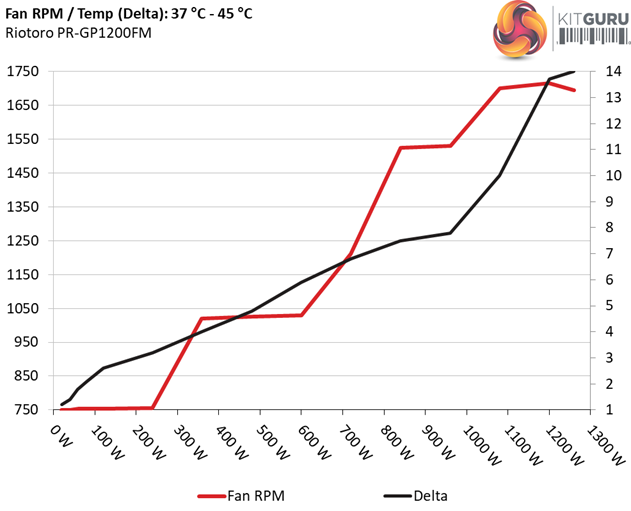
The next chart shows the fan's speed (again, in RPM) and output noise. We measure acoustics from one meter away, inside a hemi-anechoic chamber. Background noise inside the chamber is below 6 dB(A) during testing (it's actually much lower, but our sound meter’s microphone hits its floor), and the results are obtained with the PSU operating at 37°C (98.6°F) to 45°C (113°F) ambient temperature.
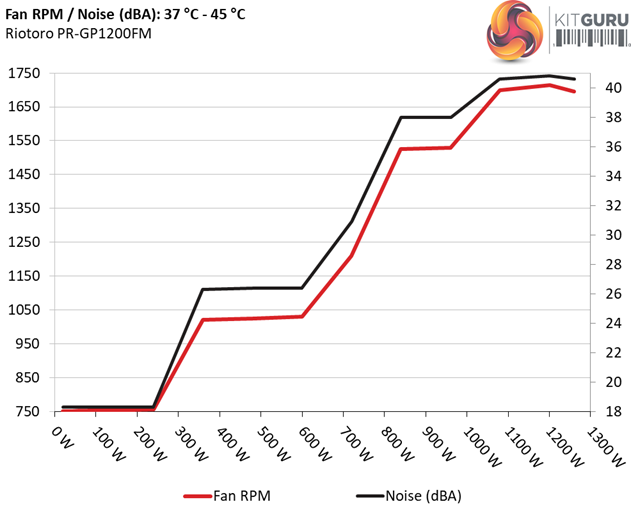
The following graph illustrates the fan's output noise over the PSU's operating range. The same conditions of the above graph apply to our measurements, though the ambient temperature is between 30°C (86°F) to 32°C (89.6°F).
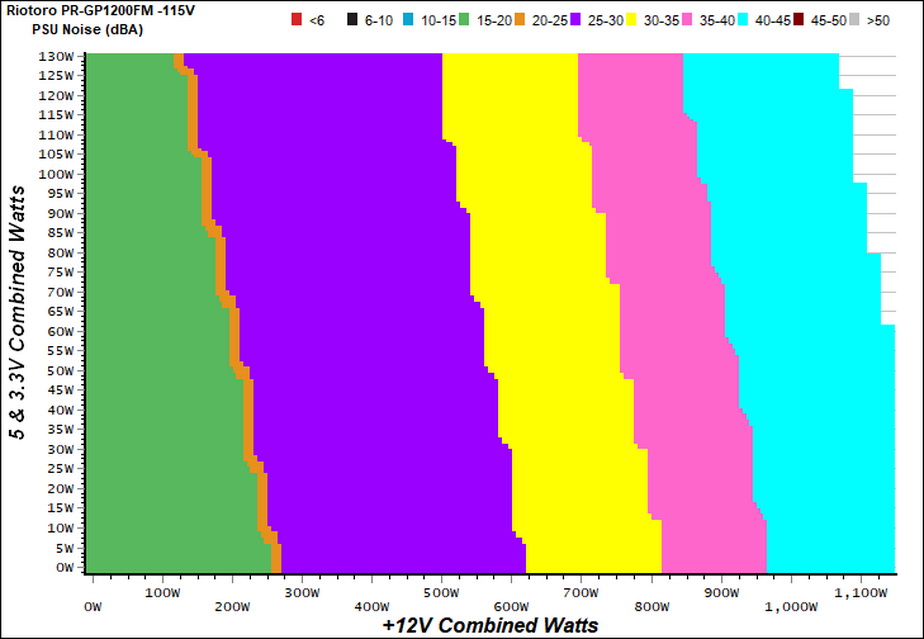
If we take into account the fan control circuit's behaviour under high operating temperatures, we expected it to be more relaxed under normal operating temperatures. Nonetheless, this is a high capacity unit so it needs to have proper airflow to ensure the internal components take the least amount of stress, in order to maximise lifespan.
With up to 290W at +12V the PSU is silent, while with up to 610W it will probably stay below most user's noise radar. In the worst case scenario, which is over 970W load at +12V, the fan's noise barely exceeds 40 dB(A).
 KitGuru KitGuru.net – Tech News | Hardware News | Hardware Reviews | IOS | Mobile | Gaming | Graphics Cards
KitGuru KitGuru.net – Tech News | Hardware News | Hardware Reviews | IOS | Mobile | Gaming | Graphics Cards


